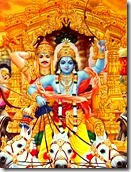 "The Lord advised that Arjuna not
be inactive, but that he perform his prescribed duty without being
attached to the result. One who is attached to the result of his work is
also the cause of the action. Thus he is the enjoyer or sufferer of the
result of such actions." (Shrila Prabhupada,
Bhagavad-gita, 2.47 Purport)
"The Lord advised that Arjuna not
be inactive, but that he perform his prescribed duty without being
attached to the result. One who is attached to the result of his work is
also the cause of the action. Thus he is the enjoyer or sufferer of the
result of such actions." (Shrila Prabhupada,
Bhagavad-gita, 2.47 Purport)“What are you doing man? Who told you to do that? Why would you on a whim do something that nobody asked you to do?” Picture being at an important jobsite where specific instructions are handed down by the superiors. They have their own interests in the establishment, ends they are trying to reach. To help speed up the process, they hire workers, paid employees who can boost productivity and thus allow for the desired outcome to arrive more quickly. The worker in this scenario has two options. He can do as he’s told or he can follow his own desires. The latter is the more risky choice, as the worker then assumes responsibility for the outcome, whereas the former keeps the burden upon the proprietor, irrespective of the end result. In the big picture of life, there is a grand proprietor who has assigned prescribed duties to every single one of us. When these duties are performed with detachment, we don’t bear the burden of responsibility for the outcome, for we are not the cause of the action. On the other hand, when personal enjoyment takes over and drives our activities, keeping us attached to the results, we become the cause. The cause bears the burden of suffering or enjoying. Since our enjoyment is temporary, taking the responsibility of the cause ends up being not worth it.
Let’s work through an example to get a firmer understanding. Staying with the office scenario, let’s say that we decided to follow our own instinct on a particular task. We had our own end to reach, something which may not have paired up with what the proprietors wanted. With every action there is the potential for two outcomes: success or failure. Let’s take the positive outcome first. We defied the orders of the superiors and went our own way and things worked out. As a result, we enjoy the credit for the success. After all, the proprietors didn’t tell us to do what we did. We took a risk and thus we own the result. Since there is attachment to the outcome, the enjoyment is there for us to take.
On the flip side, when there is failure, the burden of responsibility is heaped directly upon us. We get all the blame for not following orders and for letting our own desires take precedent. The negative, unsuccessful outcomes must be attached to us as well, for we made the decision based on personal desire to go against the instructions given to us.
 The risk in following
our own instincts is that we may not be as familiar with the nature of
the task and the final end being supported as the proprietors are. The
proprietors keep a big picture vision, while the workers are there to
earn a paycheck. The worker enjoys time off and vacations, while the
owner dreads these days, for they halt productivity. Think of it like
the difference between the students and the teacher in a particular
classroom. If there is a massive blizzard hitting the area that closes
school, the students love it, but for the teacher there is not that much
happiness. The class exists for a reason, to provide instruction to
students, valuable information that they can hopefully use in the
future. If class is cancelled, what benefit is there to be gained? The
students, however, don’t know any better. Their position is completely
different from the person providing the instruction, the teacher.
Therefore, should the students act on their own whims, becoming attached
to the outcomes, either favorable or unfavorable, they won’t be guided
by the proper vision. Even a blind man can find the right way to go by
chance, so not every divergence from instruction will lead to failure,
but even the successes in these instances won’t correspond fully with
the desires of the leader.
The risk in following
our own instincts is that we may not be as familiar with the nature of
the task and the final end being supported as the proprietors are. The
proprietors keep a big picture vision, while the workers are there to
earn a paycheck. The worker enjoys time off and vacations, while the
owner dreads these days, for they halt productivity. Think of it like
the difference between the students and the teacher in a particular
classroom. If there is a massive blizzard hitting the area that closes
school, the students love it, but for the teacher there is not that much
happiness. The class exists for a reason, to provide instruction to
students, valuable information that they can hopefully use in the
future. If class is cancelled, what benefit is there to be gained? The
students, however, don’t know any better. Their position is completely
different from the person providing the instruction, the teacher.
Therefore, should the students act on their own whims, becoming attached
to the outcomes, either favorable or unfavorable, they won’t be guided
by the proper vision. Even a blind man can find the right way to go by
chance, so not every divergence from instruction will lead to failure,
but even the successes in these instances won’t correspond fully with
the desires of the leader.What does this all mean in the grand scheme of things? Religion exists to guide mankind in his conduct. The person instituting the principles of real religion understands the highest goal; He knows what is ultimately best for all of us. We, on the other hand, require instruction at every stage in life. If this weren’t true, we would just play throughout our time on earth and never get educated. Instruction and discipline are imposed on children because they don’t know any better; kids are less intelligent than adults.
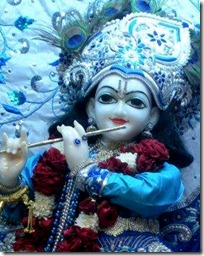 While the young child
eventually matures into an adult and thus increases their intelligence,
there is one person who never has to mature. He has always possessed
complete knowledge and bliss. This means that He has never lost His
intelligence, nor has He found periods of sadness that He needed to get
out of. Moreover, He never takes birth or dies. He remains in His
spiritual body for all of eternity.
While the young child
eventually matures into an adult and thus increases their intelligence,
there is one person who never has to mature. He has always possessed
complete knowledge and bliss. This means that He has never lost His
intelligence, nor has He found periods of sadness that He needed to get
out of. Moreover, He never takes birth or dies. He remains in His
spiritual body for all of eternity.We spirit souls are like His children. We too never take birth or die, but we can travel through different species. With each change in residence the maturation cycle resets, wherein we have to become educated again on how to live. Depending on the dwelling accepted, the educational needs can vary. For instance, a cow’s primary duties are different from a pig’s. A bird has to acquire tools that a tiger may not have to. All in all, the animals are the same in that they follow eating, sleeping, mating and defending as their primary behaviors.
A human birth, on the other hand, is considered the most auspicious because with it the highest information can be attained. Lest we think this relates to only personal sense enjoyment, the information to be accepted serves a higher purpose. An eternal body similar to that belonging to our spiritual father can be acquired through the proper channels. Since we have no clue about the difference between body and spirit, the need for education, the travels through the many species, and the benefits of following the advice of superiors, we need something to guide us through life, to keep us on the straightened path. Hence we see why religion exists. Some prefer not to use the term “religion”, since it evokes memories of phony leaders who are either after money or telling everyone that they are being punished for not swearing allegiance to a specific personality.
In the Vedas, religion is referred to as dharma, which means one’s occupational duty. Dharma as a term says that it has always been the soul’s business to follow the law codes handed down by the Supreme Person, and that adherence to these codes will continue to be the foremost occupational duty going forward. Dharma in this sense is not a punishment, but rather the greatest blessing. Think of it as the instruction manual for life, intended to allow one to assemble everything properly, to make sure that unexpected deviations from the auspicious path do not take place. With every setback comes an increase in the number of hardships encountered, with the chances of meeting the highest end put into jeopardy. Dharma is there to teach us how to push the massive rock symbolic of the spirit soul to the top of the hill, where it belongs. Deviation from dharma helps to make that task more difficult, with the worst sins causing the rock to roll back down the hill.
 When dharma is
followed, there is no need for attachment to the result. For instance,
if dharma calls for us to be honest in our dealings, to follow religious
rituals and regulations on a regular basis, and to protect our loved
ones, whether we receive successful outcomes or not is out of our
control. Dharma comes from God, so He assumes the responsibility for the
results coming from its practice. Moreover, when we act without
attachment, we are not even the cause of the actions and their results.
The person instituting the rules bears the burden of responsibility; and
since He is the Supreme Person, He is more than happy to accept it.
When dharma is
followed, there is no need for attachment to the result. For instance,
if dharma calls for us to be honest in our dealings, to follow religious
rituals and regulations on a regular basis, and to protect our loved
ones, whether we receive successful outcomes or not is out of our
control. Dharma comes from God, so He assumes the responsibility for the
results coming from its practice. Moreover, when we act without
attachment, we are not even the cause of the actions and their results.
The person instituting the rules bears the burden of responsibility; and
since He is the Supreme Person, He is more than happy to accept it.On the other hand, when we don’t follow dharma, there is attachment to the outcomes. With attachment comes responsibility. Lest we think this is the better option because of the potential for enjoying success, look at what happens when a little success is encountered. The taste of victory seems very sweet, but it does not last very long. Therefore another plunge into the engagement is required. Just because we were successful once doesn’t mean that we will be again. For someone who has succeeded many times in the past, defeat brings a bitter taste. Someone who is unattached will not feel as morose over defeat, but someone who has tasted victory will hate losing.
Even the successes that do come from deviating from dharma don’t carry any progression along life’s ultimate path. Though dharma can be targeted to different people based on their natural qualities and their positions in life, the Vedas have delineated four activities as being the most detrimental, the strongest deviations from the righteous path. They are meat eating, gambling, intoxication and illicit sex. Each of these behaviors carries an enjoyment, but even with the successful outcome there is no progress made. The person instituting dharma created its laws to allow for consciousness to gradually shift to the spiritual plane. Consciousness is the determining factor not only in present happiness, but also in the future fortunes of the soul. The God conscious individual doesn’t have to reset the cycle of maturation by accepting another body. They assume their natural form, or svarupa, upon exiting the body.
“Whatever state of being one remembers when he quits his body, that state he will attain without fail.” (Lord Krishna, Bhagavad-gita, 8.6)
 The benefits of
following dharma and remaining unattached to outcomes are nicely
described in the Bhagavad-gita, the Song of God sung by Lord
Krishna, the Supreme Personality of Godhead. While dharma entrusted
to spiritual leaders is enough to give us guidance in life, the Supreme
Lord knows that following it will be difficult. The material world is
conducive for violating the righteous path. It’s as if someone
constantly stays with us and whispers in our ear to buck authority and
go against the grain. “Don’t follow religion. God is dead. You are God.
Why should you worship anyone else?”
The benefits of
following dharma and remaining unattached to outcomes are nicely
described in the Bhagavad-gita, the Song of God sung by Lord
Krishna, the Supreme Personality of Godhead. While dharma entrusted
to spiritual leaders is enough to give us guidance in life, the Supreme
Lord knows that following it will be difficult. The material world is
conducive for violating the righteous path. It’s as if someone
constantly stays with us and whispers in our ear to buck authority and
go against the grain. “Don’t follow religion. God is dead. You are God.
Why should you worship anyone else?”The Bhagavad-gita is a theoretical treatise coupled with a real-life situation that allowed for the principles discussed to be implemented. The work opens with the plight of a warrior who was about to engage in one of the bloodiest wars in history. His side was justified in fighting, as they were unjustly kicked out of their kingdom. Moreover, they were members of the warrior class; so they were obligated by dharma to protect and defend the innocent. Just imagine if someone breaks into your home, you call the police, and they say that they don’t feel like defending you. The police say that they don’t think it’s right to punish someone for stealing because they, the authorities in charge of upholding the law, have decided that stealing is not immoral. Obviously the policeman in question would hopefully get into trouble, for he is not following his prescribed duties.
The lead fighter on this particular day was hesitant to enter into hostilities, not wanting to harm the family members fighting for the opposing army. Violating dharma and following his own whim, this fighter decided it was better to throw in the towel, to just give up. Krishna, knowing full well the influence His material nature has on the consciousness, stepped in and educated His cousin and disciple, the hesitant warrior Arjuna. In trying to convince him of the proper path, Krishna told him that by harboring attachment to outcomes, one must suffer the result. Such workers essentially become the cause of their fortunes and misfortunes. This meant that if Arjuna gave up, he would be the cause for whatever would follow. God could not be blamed.
 On the other hand, if
Arjuna followed his prescribed duties, which were originally put into
place by Krishna Himself, the Lord would assume responsibility for the
outcome. Arjuna had no reason to be attached to the results of his
actions, for he would just be acting in the interests of the self. The
self is the soul, or atma, which is the identifying agent within
every life form. The real self-interest is to follow dharma, for the law
codes handed down by God are meant for benefitting the soul only. The
body is temporary, as are the senses. One who gives in to the
temptations to violate dharma does so at the behest of the senses, which
will eventually be discarded. Therefore the enjoyment that results will
similarly be limited; it cannot transcend the bounds of birth and
death.
On the other hand, if
Arjuna followed his prescribed duties, which were originally put into
place by Krishna Himself, the Lord would assume responsibility for the
outcome. Arjuna had no reason to be attached to the results of his
actions, for he would just be acting in the interests of the self. The
self is the soul, or atma, which is the identifying agent within
every life form. The real self-interest is to follow dharma, for the law
codes handed down by God are meant for benefitting the soul only. The
body is temporary, as are the senses. One who gives in to the
temptations to violate dharma does so at the behest of the senses, which
will eventually be discarded. Therefore the enjoyment that results will
similarly be limited; it cannot transcend the bounds of birth and
death.Arjuna would heed Krishna’s advice and fight on, all the while remaining unattached to the outcome. As strong as his dispassion was, he was more firmly dedicated to Krishna’s service, to pleasing his beloved friend and cousin. Krishna, or God, is everyone’s father, so following dharma automatically pleases Him. The person who institutes the laws and takes responsibility for the outcome of actions performed under their direction ensures that the outcome is always the right one. If our primary occupational duty is to serve Krishna and make Him happy, how could anything we do that follows that mindset be incorrect? Moreover, how could we ever fail? Krishna controls the outcome, so He will never deny the soul sincerely interested in following dharma, a system which keeps them in line with their ultimate characteristic, that of servant of God.
In Closing:
The orders of commanders with attention do you hear,
Follow them for the consequences of not you fear.
But if you go against, if to orders you don’t listen,
For the outcome, good or bad, you will bear the burden.
If you are successful, what did you really learn?
Only a false sense of control did you earn.
If you follow orders, for outcome you’re not responsible,
Person who instituted the rules is liable.
In the grander scheme follow the Supreme Lord’s laws,
Of
every outcome He is the original cause.
Work without attachment
so you don’t have to worry,Follow path of Arjuna, who shot arrows in a flurry.
He worked for Krishna so there was no question of failure,
With sincerity in devotion, to see success one is sure.
 “Never in the past was there, nor in the future will there be, a man like Janaka, who had Sita as a daughter, full of all auspiciousness.” (Janaki Mangala, Svayamvara Ki Taiyari, 7)
“Never in the past was there, nor in the future will there be, a man like Janaka, who had Sita as a daughter, full of all auspiciousness.” (Janaki Mangala, Svayamvara Ki Taiyari, 7) Limited by time is the human being. There is only so much that can be accomplished in a given day, for there are so many responsibilities to take care of. During the week there is the grind of the forty hours of work during the daytime coupled with the responsibilities pertaining to home and family at night. Then on the weekend one can tend to all the chores they skipped during the busy week. In this way there is not much that can be done to introduce new activities into the routine of the average adult. Therefore the activities that one does take up become even more important. The more inclusive they are in scope, the more they take care of multiple needs, the better the benefit derived will be.
Limited by time is the human being. There is only so much that can be accomplished in a given day, for there are so many responsibilities to take care of. During the week there is the grind of the forty hours of work during the daytime coupled with the responsibilities pertaining to home and family at night. Then on the weekend one can tend to all the chores they skipped during the busy week. In this way there is not much that can be done to introduce new activities into the routine of the average adult. Therefore the activities that one does take up become even more important. The more inclusive they are in scope, the more they take care of multiple needs, the better the benefit derived will be.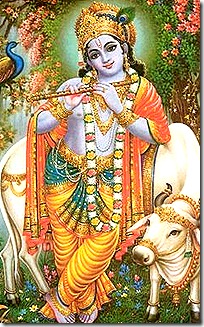 In the Vedic tradition, the most inclusive type of meditation involves focus on the transcendental form of the Personality of Godhead, who is known as Krishna because of His sweetness. He is so attractive that one who has removed the influence of the senses can’t help but remain devoted to Him. Indeed, it is only the influence of the material nature that causes any living entity to become forgetful of their constitutional position of lover of God. When afflicted by the material disease, the same loving spirit is present, but it gets directed towards areas that don’t merit the attention. Moreover, the love is then qualified, almost a type of lust. The “love” only lasts for as long as there is a benefit received. As soon as that stops, the loving spirit gets directed elsewhere.
In the Vedic tradition, the most inclusive type of meditation involves focus on the transcendental form of the Personality of Godhead, who is known as Krishna because of His sweetness. He is so attractive that one who has removed the influence of the senses can’t help but remain devoted to Him. Indeed, it is only the influence of the material nature that causes any living entity to become forgetful of their constitutional position of lover of God. When afflicted by the material disease, the same loving spirit is present, but it gets directed towards areas that don’t merit the attention. Moreover, the love is then qualified, almost a type of lust. The “love” only lasts for as long as there is a benefit received. As soon as that stops, the loving spirit gets directed elsewhere.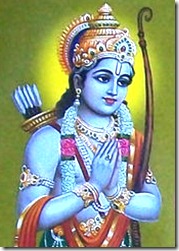 If Tulsidas worshiped Rama exclusively through bhakti, why would he author a poem called the Janaki Mangala. Once we find out that Janaki is Rama’s wife and that the mangala refers to the auspiciousness of her marriage ceremony to Rama, the purpose behind the composition becomes self-evident. If you love God, you’re going to love His wife. Just as Rama is non-different from Krishna and Vishnu, Sita is non-different from Shrimati
If Tulsidas worshiped Rama exclusively through bhakti, why would he author a poem called the Janaki Mangala. Once we find out that Janaki is Rama’s wife and that the mangala refers to the auspiciousness of her marriage ceremony to Rama, the purpose behind the composition becomes self-evident. If you love God, you’re going to love His wife. Just as Rama is non-different from Krishna and Vishnu, Sita is non-different from Shrimati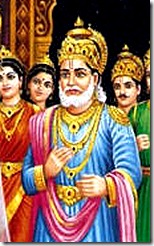 Or so it was thought. When he found a baby girl in the ground one day while ploughing a field, his life would change forever. The same king that was already famous for his dedication to religious principles would gain supreme auspiciousness in accepting this girl as his daughter. Since she came out of the ground he named her Sita, and through her he would gain Shri Rama as a son-in-law. In this way Janaka proved himself ever worthy of God’s favor, for the Supreme Lord’s wife chose him as a father during her time on earth.
Or so it was thought. When he found a baby girl in the ground one day while ploughing a field, his life would change forever. The same king that was already famous for his dedication to religious principles would gain supreme auspiciousness in accepting this girl as his daughter. Since she came out of the ground he named her Sita, and through her he would gain Shri Rama as a son-in-law. In this way Janaka proved himself ever worthy of God’s favor, for the Supreme Lord’s wife chose him as a father during her time on earth.